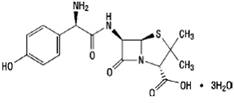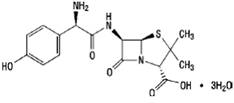 Français
Français Amoxicillin
Amoxicillin is an extended spectrum penicillin group of antibiotic. Amoxicillin is active against many gram positive and gram negative bacteria.
Chemical structure
The molecular formula is C16H19N3O5S•3H2O and the molecular weight is 419.45. The chemical structure is:

Mechanism of action
Amoxicillin acts by inhibiting bacterial cell wall synthesis. Lack of bacterial cell wall results in death due to lysis of bacteria. So amoxicillin is useful only for actively growing and cell wall synthesizing bacteria.
Pharmacokinetics
Food does not interfere with absorption of amoxicillin. It crosses the placenta; small amounts are distributed into breast milk. The half-life of amoxicillin is 61.3 minutes. Amoxicillin is excreted mainly by kidney and by hepatic metabolism. Its excretion can be delayed by concomitant administration of probenecid.
Pregnancy: Teratogenic Effects: Pregnancy Category B. Animal studies have revealed no evidence of harm to the foetus due to amoxicillin.
Nursing Mothers: Amoxicillin is excreted in breast milk and may lead to sensitization of infants.
Paediatric Use: As renal function is incompletely developed in neonates and young infants, the elimination of amoxicillin may be delayed.
Antimicrobial spectrum
Amoxicillin is active against gram positive bacteria like Enterococcus faecalis, Staphylococcus species, Streptococcus species,
Streptococcus pneumonia and gram negative bacteria like Escherichia coli, Haemophilus influenza, Proteus mirabilis, Neisseria gonorrhoeae. Amoxicillin is also active against Helicobacter pylori but it is not effective against Pseudomonas, Klebsiella, Serratia, Citrobacter and some Gram negative aerobes.
Indications and usage
Amoxicillin is used in the treatment of infections due to susceptible microorganisms causing infections of the ear, nose, throat, lower respiratory tract, genitourinary tract, skin.
It is also used in multidrug regimen for eradication of Helicobacter pylori in peptic ulcers.
Administration and dosage
| Patients | Dose |
| Adults | 250-500 mg every 8 hours OR 500-875 mg every 12 hours |
| Children up to 10 years | 125-250 mg every 8 hours |
| Patients under 40 kg | 20-40 mg/kg daily in divided doses every 8 hours OR 25-45 mg/kg daily in divided doses every 12 hours |
| Infants < 3 months old | Maximum dose of 30 mg/kg daily in divided doses every 12 hours |
Precautions, Contraindications and Warnings
Hypersensitivity can occur in 5-8% of patients receiving penicillin group of antibiotic. In case of any allergic reaction stop amoxicillin. History of allergic reaction to any of the penicillins is a contraindication for use of amoxicillin.
Adverse reactions
Hypersensitivity reactions, nausea, vomiting, diarrhoea, rashes may occur with amoxicillin. Rare side effects include serum sickness–like reactions, toxic epidermal necrolysis, hemolytic anemia, anxiety, insomnia, cholestatic jaundice, nephritis.
Technical Description on Amoxicillin
Amoxicillin is an extended spectrum, penicillinase-susceptible, semi-synthetic amino- penicillin. It is a close chemical and pharmacological congener of ampicillin (amino-p-hydroxy-benzyl penicillin).
Chemical structure
The molecular formula is C16H19N3O5S•3H2O and the molecular weight is 419.45. The chemical structure is:

Preparations available
- Capsules: contains 500 mg amoxicillin trihydrate.
- Tablet: contains 500/875 mg amoxicillin trihydrate.
- Chewable tablet: 200/400 mg amoxicillin trihydrate.
- Powder for Oral Suspension: Each 5 mL of reconstituted suspension contains 200 mg, 250 mg, or 400 mg amoxicillin trihydrate.
- Paediatric Drops for Oral Suspension: Each mL of reconstituted suspension contains 50 mg amoxicillin trihydrate.
Mechanism of action
Amoxicillin like other penicillins, inhibit thepenicillin binding proteins (PBPs {specifically PBP-1A}), which are transmembrane surface enzymes that catalyse the cross linking (transpeptidation) between the peptidoglycans in the bacterial cell wall. Amoxicillin is able to bind to the PBPs by geometrically mimicking the natural D-alanyl-D-alanine substrate that is generally bound to the enzyme. By substituting itself for D-alanyl-D-alanine, the appropriate strands needed for cross-linking are not available and the cell wall biosynthesis process is left incomplete.
Italso acylates the penicillin-sensitive transpeptidase C-terminal domain by opening the lactam ring. This inactivation of the enzyme prevents the formation of a cross-link of two linear peptidoglycan strands, inhibiting bacterial cell wall synthesis. Cell lysis is then mediated by bacterial cell wall autolytic enzymes such as autolysins or murein hydrolases; it is possible that amoxicillin interferes with an autolysin inhibitor.
In gram negative bacteria the outer membrane of cell wall comprises of lipopoly saccharides with narrow porin channels which function as barriers to permeability of beta-lactam antibiotics.But amoxicillin being hydrophiliccan diffuse through these porin channels more swiftly and significantly than other natural penicillins and show activity against gram negative bacteria also.
Beta- Lactam antibiotics including amoxicillin kill bacterial cells only when they are actively growing and synthesizing cell wall.
Resistance
Like other penicillins, resistance to amoxicillin is due to one of four general mechanisms: (1) inactivation of antibiotic by Beta-lactamase, (2) efflux (3) impaired penetration of drug to target PBPs, and (4) modification of target PBPs. Beta-Lactamase production is the most common mechanism of resistance. Complete cross-resistance has been reported between amoxicillin and ampicillin.
Pharmacokinetics
As compared to ampicillin, amoxicillin is stable in the presence of gastric acid, oral absorption is better, food does not interfere with absorption, higher and more sustained blood levels are produced. It is about 20% protein-bound. Amoxicillin diffuses readily into most body tissues and fluids, with the exception of brain and spinal fluid, except when meninges are inflamed.It crosses the placenta; small amounts are distributed into breast milk.
The half-life of amoxicillin is 61.3 minutes. The half-life may be prolonged in neonates, the elderly, and patients with renal impairment; in severe renal impairment the half-life may be 7 to 20 hours.Peak plasma concentrations of amoxicillin are 2-2.5 times higher for amoxicillin than for ampicillin after oral administration of the same dose; they are reached at 2 hours and average ~4 mcg/mL when 250 mg is administered.
About 60 % of an oral dose is excreted unchangedin urine in 6 hours by glomerular filtration and tubular secretion and a limited extent is metabolized to penicilloic acid. Its excretion can be delayed by concomitant administration of probenecid. Hepatic metabolism accounts for less than 30% of the biotransformation like otherpenicillins.
Pregnancy: Teratogenic Effects: Pregnancy Category B. Animal studies have revealed no evidence of harm to the foetus due to amoxicillin.
Nursing Mothers: Amoxicillin is excreted in breast milk and may lead to sensitization of infants.
Paediatric Use: As renal function is incompletely developed in neonates and young infants, the elimination of amoxicillin may be delayed.
Antimicrobial Action - Sensitive organisms
1. Aerobic Gram-Positive Microorganisms:
Enterococcus faecalis
Staphylococcus species* (β-lactamase–negative strains only)
Streptococcus spp. (α- and β-hemolytic strains only)
Streptococcus pneumoniae
* Staphylococci which are susceptible to amoxicillin but resistant to methicillin/oxacillin should be considered as resistant to amoxicillin.
2. Aerobic Gram-Negative Microorganisms: (β-lactamase–negative strains only)
Escherichia coli
Haemophilus influenzae
Proteus mirabilis
Neisseria gonorrhoeae
3. Helicobacter: Helicobacter pylori
Amoxicillin has been reported to be more active in vitro than ampicillin against Enterococcus faecalis, Helicobacter pylori, and Salmonella species, but less active against Shigellaspecies.
It is most active of all oral beta-lactams against penicillin resistant streptococcus pneumoniae.
Indications and usage
Amoxicillin is indicated in the treatment of infections due to susceptible (Only β-lactamase–negative) strains of selected microorganisms in the disorders given below:
Infections of the ear, nose,throat and lower respiratory tract– due to Streptococcus species (α- and β-hemolytic strains only), S. pneumoniae, Staphylococcus species, or H. influenzae.
Gonorrhoea, acute uncomplicated (ano-genital and urethral infections) – due to N. gonorrhoeae.
Infections of the genitourinary tract – due to E. coli, P. mirabilis, or E. faecalis.
Infections of the skin and appendages– due to Streptococcus species. (α- and β-hemolytic strains only), Staphylococcus species, or E. coli.
Triple Therapy: Amoxicillin, in combination with clarithromycin plus lansoprazole , is indicated for the treatment of H. pylori infection and duodenal ulcer disease to eradicate H. pylori.
Dual Therapy: Amoxicillin, in combination with lansoprazole, is indicated for the treatment of H. pylori infection and duodenal ulcer diseasein patients who are either allergic or intolerant to clarithromycin or in whom resistance to clarithromycin is known or suspected.
Administration and dosage
| Patients | Dose |
| Adults | 250-500 mg every 8 hours OR 500-875 mg every 12 hours |
| Children up to 10 years | 125-250 mg every 8 hours |
| Patients under 40 kg | 20-40 mg/kg daily in divided doses every 8 hours OR 25-45 mg/kg daily in divided doses every 12 hours |
| Infants < 3 months old | Maximum dose of 30 mg/kg daily in divided doses every 12 hours |
Amoxicillin can be given as a single dose of 3 g, with probenecid 1 g, in the treatment of uncomplicated gonorrhoea in gonococci sensitive areas.
Doses may need to be reduced in moderate to severe renal impairment.
Precautions
The likelihood of superinfections with fungal or bacterial pathogens should be known during therapy.
A number of patients with mononucleosis who receive ampicillin develop an erythematous skin rash. Hence, ampicillin-class antibiotics including amoxicillin should not be given to such patients.
Contraindications and Warnings
Before starting treatment with amoxicillin vigilant investigation should be done concerning previous hypersensitivity reactions to penicillins, cephalosporins or other allergens. Otherwise it can lead to serious and occasionally fatal hypersensitivity (anaphylactic) reactions. If an allergic reaction occurs, amoxicillin should be stopped and appropriate emergency therapy should be instituted. Thus a history of allergic reaction to any of the penicillins is a contraindication.
Clostridium difficile associated diarrhea (CDAD) has been seen with use of all antibacterial agents, including amoxicillin, and may range in severity from mild diarrhea to fatal colitis.
Drug Interactions:Concurrent use of amoxicillin and probenecid may result in increased and prolonged blood levels of amoxicillin as probenecid reduces the renal tubular secretion of amoxicillin.
Macrolides, sulfonamides, chloramphenicol, and tetracyclines may interfere with the bactericidal effects of amoxicillin. Also amoxicillin may interact with methotrexate.
Like other antibiotics, amoxicillin may affect the gut flora, and reduce the efficacy of combined oral estrogen/progesterone contraceptives and oral anticoagulants.
Drug/Laboratory Test Interactions:Like ampicillin, high urine concentrations of amoxicillin may result in false-positive reactions when testing for the presence of glucose in urine using Benedict’s Solution, or Fehling’s Solution.
Like ampicillin, a transient decrease in plasma concentration of total conjugated estriol, estriol-glucuronide, conjugated estrone, and estradiol can occur in pregnant women taking amoxicillin.
Adverse reactions
Infections and Infestations: Superinfection, Mucocutaneous candidiasis.
Gastrointestinal:Nausea, vomiting, diarrhea, black hairy tongue, and hemorrhagic/pseudomembranous colitis.
Hypersensitivity Reactions: Anaphylaxis,Serum sickness–like reactions, erythematous maculopapular rashes, exfoliative dermatitis, toxic epidermal necrolysis, acute generalized exanthematous pustulosis, erythema multiforme, Stevens-Johnson syndrome, hypersensitivity vasculitis and urticaria.
Hematopoietic and Lymphatic Systems: Anemia, including hemolytic anemia, thrombocytopenia, thrombocytopenic purpura, eosinophilia, leukopenia, and agranulocytosis may occur. These are due to hypersensitivity and usually reversible on stoppage of therapy.
Central Nervous System: Reversible hyperactivity, agitation, anxiety, insomnia, confusion, convulsions, behavioral changes, and/or dizziness are seen rarely.
Liver: Rarely cholestatic jaundice, hepatic cholestasis and acute cytolytic hepatitis.
Renal: Rarely crystalluria, nephritis.